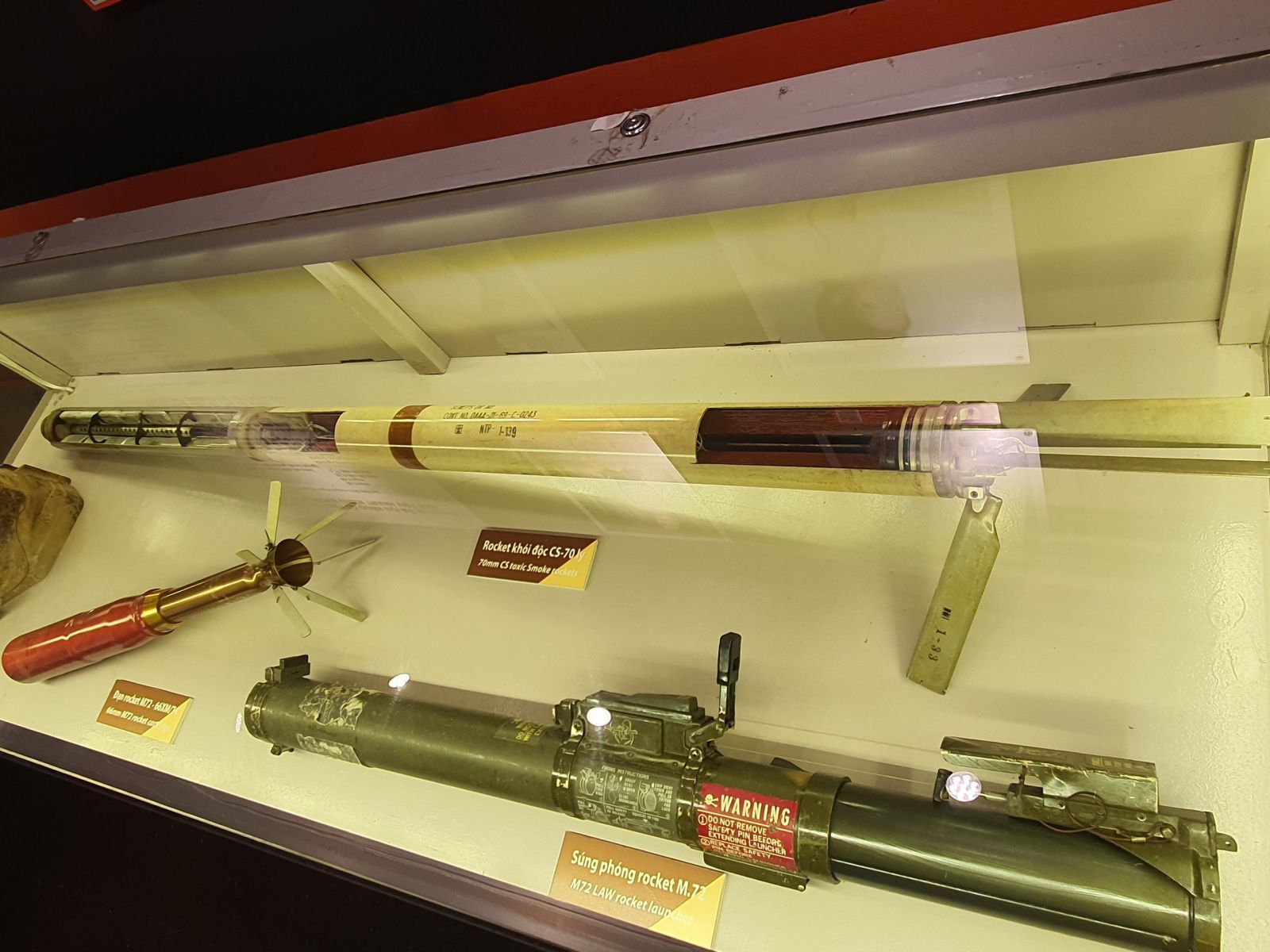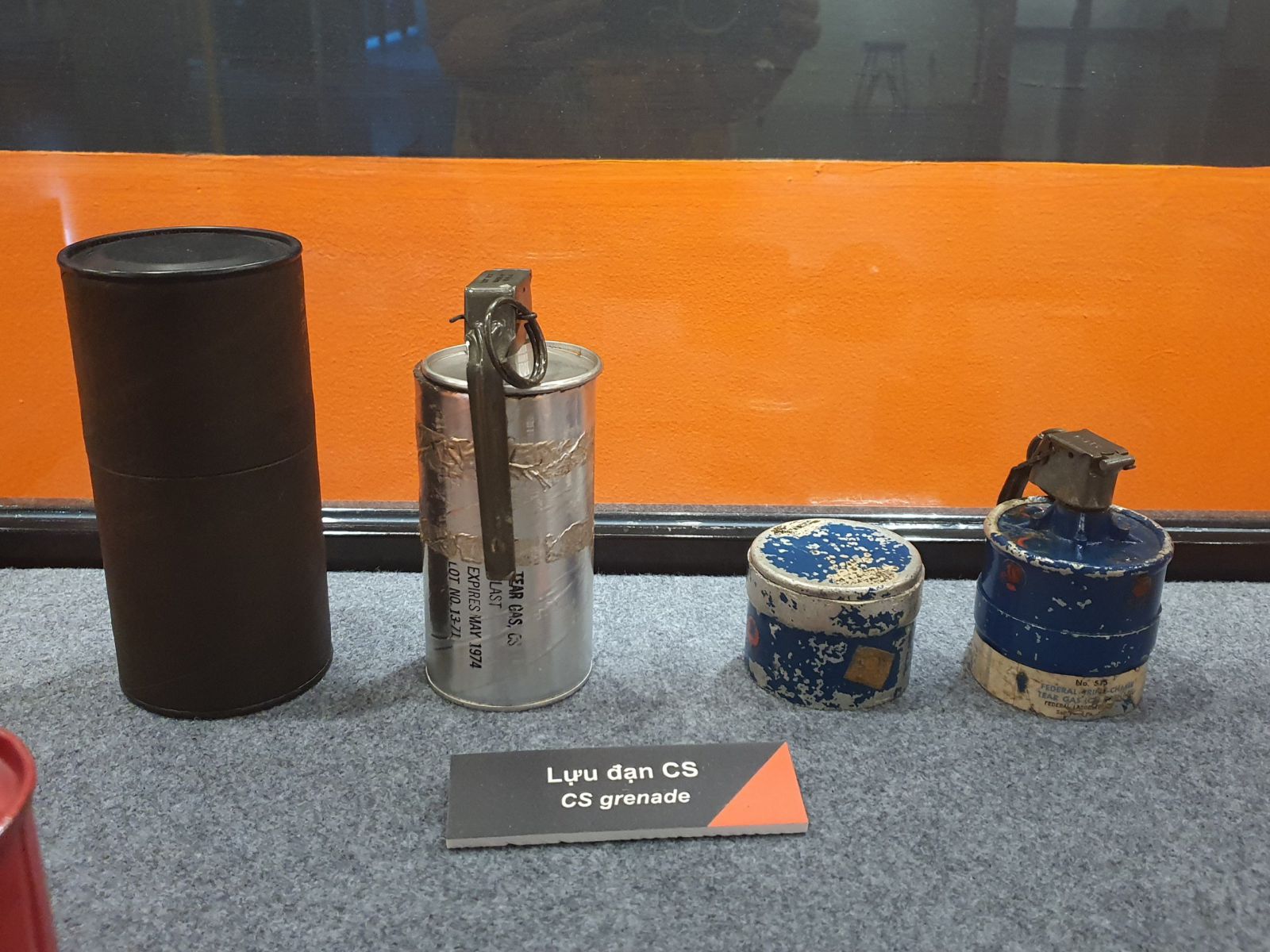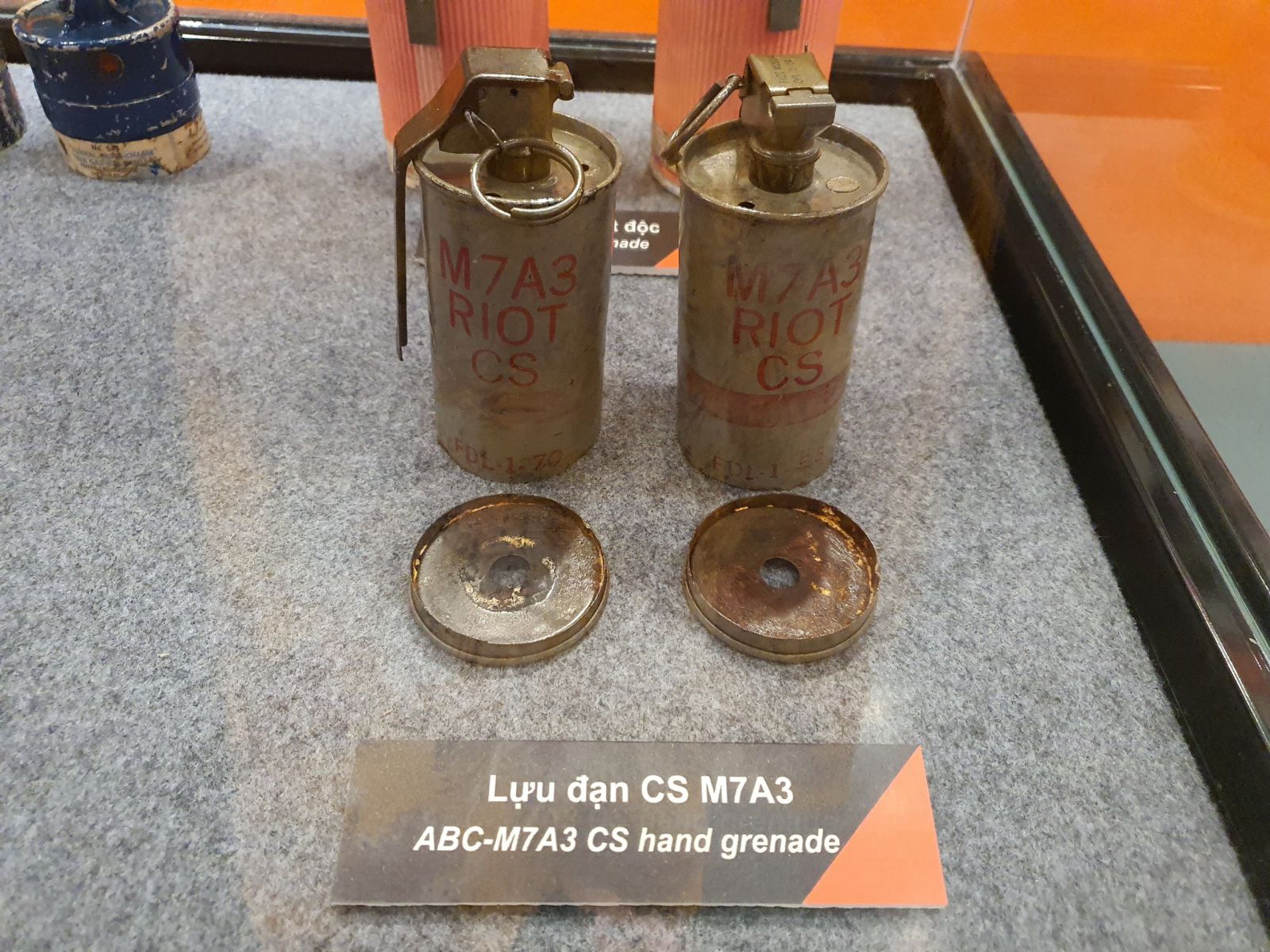When carrying out the war of aggression in Vietnam, in addition to lethal weapons and elite troops, the US military also brought a huge amount of chemicals into Vietnam. Today, the consequences of the US military's use of herbicides such as Agent Orange have become increasingly clear, recognized by both Vietnam and the United States, but the consequences of other toxic chemicals Many people still haven't mentioned it, including CS poison.
When visiting the War Remnants Museum, many visitors are curious about the CS-70mm toxic smoke rocket artifacts, CS grenades, and CS M7A3 grenades. CS is a type of poison that can be loaded into many types of explosive weapons or spraying devices such as bombs, bullets, cans, drums, launchers, etc. These artifacts are just some of them.



Artifacts containing CS are on display at the War Remnants Museum.
What is CS poison?
CS is the common name of the compound 2-chlorobenzalmalononitrile (or o-chlorobenzylidene malononitrile), with the chemical formula C10H5ClN2 (or ClC6H4CH=C(CN)2). Although often considered one of the types of "tear gas", CS is actually not a gas but exists in the form of an ivory white fine powder with a slight pepper smell. Melting point at 93 degrees C - 95 degrees C, boiling point at 310 degrees C - 315 degrees C.
.jpg)
CS is almost insoluble in water (solubility rate is only 0.008% at room temperature), soluble in organic solvents such as acetone, benzene, chloroform, dioxane, ethylacetate and carbondisulfide. CS has the ability to evaporate strongly and diffuse quickly in the air.
What are the consequences of CS poison? In chemical safety classification, CS is classified as an acute poison, an irritant, and toxic to the environment, human body, and animals. It can be harmful to humans at very low concentrations. The exposure limit concentration of CS is very low, only about 0.4 mg/m3 (0.05 ppm). At high concentrations of 25,000 - 50,000 mg/m3/min, in tunnels and tunnels, it can be fatal to humans.
CS is an alkylating agent that will react with the sulphydryl radical (SH) in the body's receptor proteins (proteins located on cell membranes, responsible for receiving chemical signals from the environment). . Thus, CS will reversibly inhibit the enzyme lactate dehydrogenase (LDH) - an enzyme dependent on the SH radical, causing this enzyme to be inactivated. This SH group is present everywhere in the body, especially nerve endings, so the impact of CS will cause irritation to the body, also known as intoxication.
The eyes, respiratory system and skin are the main organs damaged by this toxic chemical. According to analysis of the effects of each ingredient of CS, compounds with 1 Halogen atom will cause stronger tear irritation than compounds with 2 or 3 Halogen atoms. Thus, it can be seen that CS only has one Chloride substituent (belonging to the Halogen group), so the irritation will be the strongest. In addition, the presence of the Nitro group also greatly increases eye irritation. If CS enters the body through the respiratory tract, it will irritate the bronchi causing burning, coughing, chest tightness, difficulty breathing, vomiting, bronchospasm and bronchial ulcers. When CS sticks to the skin, it can cause mild burns. The effect on the skin does not last as long as the effect on other parts of the body. However, because CS adheres well to clothing, this effect will last longer, and if the exposure time is long enough, victims exposed to CS will suffer severe burns. In addition, because CS is easily adsorbed on the surface of porous materials such as wool, felt, fabric, wood, tile, straw, etc., when sprayed, it will easily stick to clothes, hair or objects, causing Victims are more susceptible to poisoning. Even when a victim exposed to CS comes into contact with another person, the poison will cause secondary exposure to the new person. This endangers people trying to help victims, police forces or rescue workers...
Colonel Nguyen Van Thoi, former Deputy Head of the General Research Department, Center for Environmental Treatment Technology (now the Institute of Military Chemistry and Environment, under the Chemical Corps) described it very briefly and easily. understand the harmful effects of CS on the organs of the human body as follows: On the eyes after 20 to 60 seconds it causes tears, red eyes, in more severe cases it can cause keratitis, vision gradually reduces to loss of fighting ability. fast. On the respiratory tract, under the effect of toxic CS vapor, you may experience continuous sneezing, coughing, throat irritation and difficulty breathing. If inhaled at high concentrations and for a long time, CS toxic vapor can enter the alveoli causing pneumonia and pulmonary congestion. When CS poison is applied to the skin, at first there will be no feeling, but after only about 2 to 3 minutes the skin will burn. If the skin is wet, it can become congested and blister when exposed to the skin. high concentration. If you are poisoned many times, you may develop allergic dermatitis: The skin is red, rough and succulent. When severely poisoned, systemic symptoms often appear such as: respiratory disorders, difficulty breathing, cardiovascular disorders, fatigue and physical weakness, exhaustion and coma leading to death.
At the same time, people exposed to CS also have effects on the digestive system. In addition to the immediate and clinical harms, research also shows that CS also causes long-term effects and threatens the victim's life. Exposure to high concentrations will cause serious complications, even death.
Many studies have also shown the carcinogenic and mutagenic effects of CS. Studies show that the mechanism of action of CS on cells does not rely on affecting the genetic material DNA, but it acts directly on the cell division machinery, causing abnormalities in chromosome division. (Chromosome) when cells are in mitosis or meiosis. This causes cells to have abnormalities in the quantity and quality of chromosomes in the cell nucleus and causes a number of harmful mutations in the body - including cancer.
The US military began using CS in Vietnam in 1962, and at that time CS was described as a type of "tear gas" that journalist Seymour Hersh pointed out: "The United States clearly began to equip gave the South Vietnamese Army two of three standard riot control gases...in 1962 under the current Military Assistance Program (MAP). The agents were CN, the standard tear gas used to quell civil disturbances, and CS, the newly developed super tear gas."
However, not only are there physical harms, but tear gas in general and CS in particular also causes terrible mental consequences for victims, as Amos Fries - Director of the Chemical Warfare Service of Vietnam said. The US Army, once commented in 1928: “It is easier for people to maintain their morale in the face of bullets than in the presence of invisible gas…Tear gas seems to be a admirably suited to the purpose of isolating the individual from the soul of the crowd … he is reduced to a condition in which he can think of nothing but relieving his own suffering. Under such conditions an army falls apart and a crowd is no more; it becomes a blind stampede to escape the source of torture.”
Because of the harmful effects and fierce effects of CS as above, there are many opinions that the name "tear gas" does not reflect the true nature of CS, "CS causes more than tear gas".
During the escalation of the war in Vietnam, the US increasingly realized the importance and effectiveness of this poison and this was also the reason that led to the US increasing the use of CS in particular. and similar substances during the war of aggression in Vietnam.
In fact, worried about the international community's opposition, the US had many hesitations and then limited the use of tear gas, including CS in April 1965, and Minister Mc Namara also ordered Westmoreland not to use tear gas in any further operations. However, based on the effectiveness of CS later, William Westmoreland - Commander of the Military Aid Command in Vietnam (1964-1968) sought to cancel the ban by proving the effectiveness of CS. Since then, the US has continued to deploy and increasingly use CS and similar substances in military activities. On October 16, 1965, Westmoreland publicly ordered American soldiers to have full authority to use poison gas in combat. The New York Forum newspaper on January 14, 1966 also reported: The US Department of Defense also officially accepted the use of toxic chemicals and toxic gas as "the most effective legal weapon to destroy the enemy" and is “a matter under the control of front command officers in Vietnam”.
Although considered one of the anti-riot agents, riot control was not the reason that motivated the US to use CS in South Vietnam in combined operations of the US and the army of the Republic of Vietnam. draw. Because the name "riot control agent" is just one of the ways the US uses to avoid condemnation from the international community for violating international regulations on the use of toxic gases in war.
It was not until 1971 that the US military stopped using toxic chemicals in the war of aggression in Vietnam. In fact, most of the drums containing herbicides at that time were punctured, rusted or dented and could not be transported directly to Johnston Island. Therefore, about more than 50% of these drums have been dismantled, chemicals are collected and transferred into healthy barrels for transportation out of Vietnam. However, the fate of CS and other chemicals was not disclosed in detail. Meanwhile, American soldiers, when evacuating their barracks and firepower at the end of the war, continued to burn or bury unused or damaged chemical warehouses, including CS, disinfectants, and solvents. lips and pesticides.
Therefore, after the liberation of CS poison and weapons and vehicles containing CS still remain in quite large quantities, mainly in warehouses, old military bases and scattered in forests. slash-and-burn fields in most southern provinces of Vietnam. Therefore, the treatment of residual communist poison in the country's territory after the war is still an urgent problem, requiring scientific treatment with a lot of effort and expense to ensure life. Safe living for people.
.jpg)
American soldiers of the 1st Cavalry Division used tear gas to "force" women and children from their hiding places, Autumn Spring, February 12, 1966. Photo: Steve Van Meter/UPI.
.jpg)
American soldiers of the 1st Cavalry Division deal with exposure to communist poison gas during a VC-organized attack on a hamlet in the Bong Son Delta, 1967. Source www.pinterest.com
.jpg)
The Chemical Corps handles bullets containing CS toxic residue left over from the war in Dong Nai province. Source: Soldiers of the Ministry of Chemistry